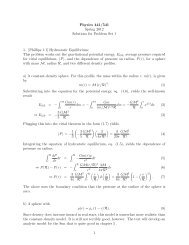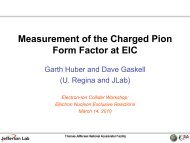Ab_init stress perturbation theory - Department of Physics and ...
Ab_init stress perturbation theory - Department of Physics and ...
Ab_init stress perturbation theory - Department of Physics and ...
Create successful ePaper yourself
Turn your PDF publications into a flip-book with our unique Google optimized e-Paper software.
Implementation <strong>of</strong> the Strain<br />
Perturbation in ABINIT<br />
D. R. Hamann, 1,2,3 Xifan Wu 1<br />
David V<strong>and</strong>erbilt, 1 Karin Rabe, 1<br />
1<br />
<strong>Department</strong> <strong>of</strong> <strong>Physics</strong> <strong>and</strong> Astronomy, Rutgers University, Piscataway, NJ<br />
2<br />
Bell Laboratories, Lucent Technologies, Murray Hill, NJ<br />
3<br />
Mat-Sim Research LLC, Murray Hill, NJ<br />
Supported by The Center for Piezoelectrics by Design, ONR grant N00014-01-1-0365<br />
<strong>and</strong> Mat-Sim Research, www.mat-simresearch.com<br />
Mat-Sim<br />
Research
Overview<br />
• Goal: Direct calculation <strong>of</strong> the elastic <strong>and</strong> piezoelectric tensors <strong>and</strong><br />
related quantities<br />
• Strain <strong>and</strong> the <strong>Ab</strong><strong>init</strong> reduced-coordinate formulation<br />
• Brief review <strong>of</strong> density functional <strong>perturbation</strong> <strong>theory</strong><br />
• Response function (RF) code organization<br />
• Development process design<br />
• Special issues: nonlocal pseudopotentials, symmetry, non-linear core<br />
corrections, cut<strong>of</strong>f smoothing, metals<br />
• Using: new input <strong>and</strong> output<br />
• Atom coordinate relaxation <strong>and</strong> anaddb post processing<br />
• Future development issues<br />
• (Appendix)
Strain tensor h ab as a <strong>perturbation</strong><br />
• Strain really only changes the positions <strong>of</strong> the atomic (pseudo)potentials,<br />
cell<br />
V () r = V ( r-τ -R) ⎯⎯→ V () r = V [ r-( 1+ η) ⋅τ- ( 1 + η) ⋅R].<br />
ext<br />
∑∑<br />
τ<br />
η ext<br />
R τ R τ<br />
cell<br />
∑∑<br />
• However, this causes unique problems for <strong>perturbation</strong>s expansions:<br />
– Viewed in terms <strong>of</strong> the inf<strong>init</strong>e lattice, the strain <strong>perturbation</strong> can never be<br />
small.<br />
– From the point <strong>of</strong> view <strong>of</strong> a single unit cell, strain changes the periodic<br />
boundary conditions, so wave functions <strong>of</strong> the strained lattice cannot be<br />
exp<strong>and</strong>ed in terms <strong>of</strong> those <strong>of</strong> the unstrained lattice.<br />
• Strain appears to be qualitatively different from other <strong>perturbation</strong>s such<br />
as periodicity-preserving atomic displacements<br />
τ
Strain tensor h ab as a <strong>perturbation</strong>, continued<br />
• Existing formulation (1)<br />
– Introduce fictitious strained self-consistent Hamiltonian obtained by a scale<br />
transformation <strong>of</strong> the unstrained Hamiltonian,<br />
H!<br />
!<br />
∇= ⎡<br />
⎣ + ⋅ + ⋅∇⎤<br />
⎦<br />
η<br />
−1<br />
SCF<br />
(, r ) HSCF<br />
(1 η) r,(1 η)<br />
H η<br />
SCF<br />
H!<br />
η<br />
– obeys the same boundary conditions as the strained Hamiltonian<br />
– has the same spectrum unstrained Hamiltonian, <strong>and</strong> a simply related<br />
SCF<br />
electron density n!<br />
η () r<br />
– Energy difference between unstrained crystal <strong>and</strong> fictitious strained crystal<br />
described by ! is easily obtained<br />
H η<br />
SCF<br />
• Problem: Hartree <strong>and</strong> XC potentials <strong>of</strong> H!<br />
η are not those generated by<br />
SCF<br />
! so ! is not a genuine Kohn-Sham Hamiltonian<br />
n η () r<br />
H η<br />
SCF<br />
– Must introduce modified external potential<br />
ext<br />
to compensate<br />
η<br />
– Then use DFPT treating ! η<br />
as the <strong>perturbation</strong><br />
V<br />
ext<br />
−V<br />
ext<br />
• Complex two-step process apparently changes the structure <strong>of</strong> DPFT from<br />
that for other <strong>perturbation</strong>s<br />
(1) S. Baroni, P. Giannozzzi, <strong>and</strong> A. Testa, Phys. Rev. Lett. 59, 2662 (1987).<br />
!<br />
V η
<strong>Ab</strong><strong>init</strong> reduced coordinate (~) formulation<br />
• Every lattice, unstrained or strained, is a unit cube in reduced coordinates.<br />
– Primitive real <strong>and</strong> reciprocal lattice vectors define the transformations:<br />
∑ ∑ ∑<br />
X = R<br />
i<br />
X! , K ≡ ( k + G ) = G K!<br />
, R G = 2πδ<br />
P P P P<br />
α α i α α α αi i αi α j ij<br />
i<br />
i<br />
α<br />
α, β ," = 1,3<br />
i, j ,"<br />
= 1,3<br />
– Cartesian indices <strong>and</strong> reduced indices<br />
• Every term in the DFT functional can be expressed in terms <strong>of</strong> dot<br />
products <strong>and</strong> the unit cell volume W.<br />
– Dot products <strong>and</strong> W in reduced coordinates are computed with metric tensors,<br />
∑<br />
X′ ⋅ X= X! ′ Ξ X! , K′ ⋅ K = K! ′ ϒ K!<br />
, Ω= (det[ Ξ ])<br />
ij<br />
i<br />
ij j<br />
i ij j<br />
ij<br />
ij<br />
• Strain is now a “simple” parameter <strong>of</strong> a density functional whose wave<br />
functions have invariant boundary conditions.<br />
∑<br />
1/2
<strong>Ab</strong><strong>init</strong> reduced coordinate (~) formulation<br />
• Strain derivatives act only on the metric tensors,<br />
Ω<br />
∂Ξ<br />
∂ϒ<br />
Ξ ≡ = R R + R R , ϒ ≡ =−G G −G G<br />
( αβ ) ij P P P P ( αβ ) ij<br />
P P P P<br />
ij αi β j βi α j ij αi β j βi<br />
α j<br />
∂ηαβ<br />
∂ηαβ<br />
∂ Ξ<br />
Ξ ≡ = ( + ) + ( + )<br />
2<br />
( αβγδ ) ij<br />
P P P P P P P P<br />
ij<br />
δαγ Rβ iRδ j<br />
Rδ iRβ j<br />
δβγ Rα iRδ j<br />
Rδ iRα<br />
j<br />
∂ηγδ<br />
∂ηαβ<br />
P P P P P P P P<br />
αδ<br />
( Rβ iRγ j<br />
Rγ iRβ j) + δβδ ( Rα iRγ j<br />
Rγ iRα<br />
j),<br />
+ δ + +<br />
• has uniquely simple derivatives for Cartesian Strains<br />
2<br />
∂Ω<br />
∂ Ω<br />
= δ Ω,<br />
= δ δ<br />
∂η ∂η ∂η<br />
αβ αβ γδ<br />
αβ αβ γδ<br />
• Key decision: strain will be Cartesian throughout the code<br />
– Existing <strong>perturbation</strong>s will remain in reduced-coordinates<br />
Ω
Stress <strong>and</strong> strain notation<br />
Cartesian xx yy zz yz xz xy<br />
Cartesian 1 1 2 2 3 3 2 3 1 3 1 2<br />
Voigt 1 2 3 4 5 6<br />
ipert, idir natom+3, 1 natom+3, 2 natom+3, 3 natom+4, 1 natom+4, 2 natom+4, 3<br />
• All forms used at various places internally <strong>and</strong> in output
Density Functional Perturbation Theory<br />
• All quantities are exp<strong>and</strong>ed in power series in a DF energy parameter l,<br />
(0) (1) 2 (2)<br />
X( λ) = X + λX + λ X +" , X = E , T, V , ψ ( r), n( r), ε , H<br />
• Solutions y (0) <strong>of</strong> Kohn-Sham equation minimize the usual DFT functional E (0)<br />
(0) (0) (0) (0)<br />
H ψα = εα ψα<br />
• The variational functional for E (2) is minimized by solutions y (1) <strong>of</strong> the selfconsistent<br />
Sternheimer equation<br />
P H P PH<br />
(0) (0) (1) (1) (0)<br />
c( − εα )<br />
c<br />
ψα =−<br />
c<br />
ψα<br />
,<br />
– where P c is the projector on unoccupied states (conduction b<strong>and</strong>s) <strong>and</strong><br />
∂ δE<br />
δ E<br />
H T V V , V n ( ′) d ′,<br />
∂<br />
∫ r r<br />
2<br />
(1) (1) (1) (1) (1) Hxc<br />
Hxc (1)<br />
= +<br />
ext<br />
+<br />
Hxc Hxc<br />
= +<br />
λδn() r (0) δn() r δn( r′<br />
)<br />
n<br />
occ<br />
(1) *(1) (0) *(0) (1)<br />
n = ∑ ψα ψα + ψα ψα<br />
α<br />
() r [ () r () r () r ()]. r<br />
el<br />
.<br />
ext<br />
α<br />
α
DFPT for elastic <strong>and</strong> piezoelectric tensors<br />
• Mixed 2 nd derivatives <strong>of</strong> the energy with respect to two <strong>perturbation</strong>s are<br />
needed.<br />
– By the “2n+1” theorem, these only require one set <strong>of</strong> 1 st order wave functions,<br />
occ<br />
( λλ 1 2) ( λ 2) ( λ1) ( λ1) ( λ1) (0)<br />
el<br />
= ∑ ψα<br />
( +<br />
ext<br />
+<br />
Hxc0)<br />
ψα<br />
α<br />
E T V H<br />
occ<br />
2<br />
+ (0) (0)<br />
∑ ψ + + α<br />
α<br />
2 ∂ ∂ 1 2<br />
• Including atomic relaxation, we need<br />
( λλ 1 2) ( λλ 1 2)<br />
Hxc<br />
( T Vext<br />
) ψα<br />
,<br />
(0)<br />
1<br />
∂ E<br />
λ λ<br />
n<br />
– Clamped-atom elastic tensor ------------<br />
– Internal strain tensor -----------------------<br />
– Interatomic force constants --------------<br />
– Clamped-atom piezoelectric tensor ----<br />
– Born effective charges ---------------------<br />
2<br />
∂ Eel<br />
∂ηαβ∂<br />
2<br />
∂ Eel<br />
∂ηαβ∂<br />
∂<br />
2<br />
2<br />
∂ Eel<br />
∂ηαβ∂<br />
∂<br />
2<br />
E<br />
E<br />
∂! τ′<br />
∂!<br />
τ<br />
el i j<br />
η<br />
! τ<br />
!<br />
γδ<br />
el<br />
∂! τ<br />
i∂E<br />
j !<br />
j<br />
E!<br />
j<br />
Available<br />
Available
Response function code organization<br />
ab<strong>init</strong><br />
driver<br />
respfn<br />
*.in<br />
*_WFK<br />
eltfr*<br />
dyfr*<br />
ipert1,idir1<br />
ipert2,idir2<br />
loper3<br />
ipert1,idir1<br />
(2)<br />
0 H 0<br />
Sternheimer Eq.,<br />
(1)<br />
K H 0<br />
scfcv3<br />
istep<br />
vtorho3<br />
vtowfk3<br />
cgwf3<br />
ikpt<br />
ib<strong>and</strong><br />
*_1WF<br />
converged?<br />
′<br />
(1)<br />
1 H 0<br />
nstwf*, nselt3, nstdy3<br />
ipert2, idir2<br />
done?<br />
d2sym3,gath3,dyout3<br />
*_DDB<br />
end
Design <strong>of</strong> development process<br />
• Four stages based on RF code organization <strong>and</strong> degree <strong>of</strong> complexity<br />
(1)<br />
(2)<br />
(1)<br />
– First K H 0 , second Sternheimer, third 0 H 0 , <strong>and</strong> fourth 1′<br />
H 0<br />
• Stage-by-stage <strong>and</strong> term-by- term validation based on existing GS first<br />
derivatives <strong>of</strong> the total energy (1DTE’s)<br />
• First stage<br />
– Re-compute <strong>stress</strong> as 0<br />
(1)<br />
H 0 = ∑ 0 K<br />
(1)<br />
K H 0<br />
K<br />
– Compare term-by term to <strong>stress</strong> breakdown available in GS calculation:<br />
<strong>stress</strong>: component 1 <strong>of</strong> hartree <strong>stress</strong> is -8.625241635590E-04<br />
<strong>stress</strong>: component 2 <strong>of</strong> hartree <strong>stress</strong> is -7.368896556922E-04<br />
<strong>stress</strong>: component 1 <strong>of</strong> loc psp <strong>stress</strong> is 2.656792257661E-03<br />
<strong>stress</strong>: component 2 <strong>of</strong> loc psp <strong>stress</strong> is 2.166978270656E-03<br />
<strong>stress</strong>: component 1 <strong>of</strong> xc <strong>stress</strong> is 4.902613744139E-03<br />
<strong>stress</strong>: component 2 <strong>of</strong> xc <strong>stress</strong> is 4.902613744139E-03<br />
<strong>stress</strong>: ii (diagonal) part is -7.753477394392E-03<br />
<strong>stress</strong>: component 1 <strong>of</strong> kinetic <strong>stress</strong> is -5.477053634248E-03<br />
<strong>stress</strong>: component 2 <strong>of</strong> kinetic <strong>stress</strong> is -5.272489903492E-03<br />
<strong>stress</strong>: component 1 <strong>of</strong> nonlocal ps <strong>stress</strong> is 2.396391029219E-03<br />
<strong>stress</strong>: component 2 <strong>of</strong> nonlocal ps <strong>stress</strong> is 1.907769135572E-03<br />
<strong>stress</strong>: component 1 <strong>of</strong> Ewald energ <strong>stress</strong> is 5.707853334522E-03<br />
<strong>stress</strong>: component 2 <strong>of</strong> Ewald energ <strong>stress</strong> is 6.846039389167E-03<br />
<strong>stress</strong>: component 1 <strong>of</strong> core xc <strong>stress</strong> is -1.789801472019E-03<br />
<strong>stress</strong>: component 2 <strong>of</strong> core xc <strong>stress</strong> is -1.911589314962E-03
Design <strong>of</strong> development process (continued)<br />
• Second through fourth stage – numerical derivatives <strong>of</strong> GS quantities<br />
– “Five-point” strain first derivatives <strong>of</strong> GS quantities (symmetric shear strains)<br />
– Strain increments small enough to keep complete {K} set invariant<br />
– Second derivatives <strong>of</strong> total energy (2DTE’s) from numerical derivatives <strong>of</strong><br />
1DTE’s (eg., <strong>stress</strong>)<br />
– Extreme convergence <strong>of</strong> self-consistency required, but not <strong>of</strong> k’s or cut<strong>of</strong>fs<br />
• Second stage – Sternheimer<br />
– Convergence <strong>of</strong> self-consistency loop<br />
– Ensure variational part <strong>of</strong> RF 2DTE’s decreases with convergence<br />
– First-order density n (1) validated by comparison with numerical n (0) derivatives<br />
• Second stage – validation <strong>of</strong> variational RF 2DTE’s<br />
(2)<br />
– Non-variational part 0 H 0 not yet available<br />
– Compute numerical 2DTE’s as above with converged GS wave functions for<br />
strained lattices<br />
– Subtract numerical 2DTE’s with strained lattices but unstrained (“frozen”) GS<br />
wave functions<br />
• So far, we are only dealing with “diagonal” 2DTE’s
Design <strong>of</strong> development process (continued)<br />
(2)<br />
• Third stage – 0 H 0 :<br />
2<br />
1 ∂ EHxc<br />
E = T + V +<br />
2 ∂ λ ∂ λ<br />
occ<br />
( λ1λ<br />
2) (0) ( λ1λ2)<br />
( λ1λ<br />
2)<br />
(0)<br />
non-var ∑ ψα<br />
(<br />
ext<br />
) ψα<br />
α<br />
– Validate term-by-term with “frozen wave function” numerical strain<br />
derivatives <strong>of</strong> <strong>stress</strong> components<br />
– Diagonal <strong>and</strong> <strong>of</strong>f-diagonal 2DTE’s<br />
1 2<br />
– Numerical strain derivatives <strong>of</strong> forces for internal strain mixed 2DTE’s<br />
– Frozen wf strain derivatives <strong>of</strong> the electric polarization are zero, so there is<br />
no contribution to piezoelectric tensor from these terms<br />
• Note that the numerical derivatives <strong>of</strong> <strong>stress</strong> need factor for<br />
2DTE comparison<br />
2<br />
∂ E el<br />
∂<br />
= Ω<br />
∂η ∂η ∂η<br />
αβ γδ αβ<br />
σ<br />
( σ<br />
γδ )<br />
Ω<br />
n<br />
(0)
Design <strong>of</strong> development process (continued)<br />
• Fourth stage –<br />
2<br />
– Use strain-<strong>perturbation</strong> wave functions<br />
– is Cartesian strain or reduced atomic displacement<br />
λ 1<br />
• Electric field is special case –<br />
occ<br />
( λ 1 λ 2) ( 2) ( 1) ( 1) ( 1) (0)<br />
non-stat<br />
= ∑ ψ<br />
λ ( λ λ λ<br />
α<br />
+<br />
ext<br />
+<br />
Hxc0)<br />
ψα<br />
α<br />
( λ )<br />
ψ α<br />
E T V H<br />
∂ E 2Ω<br />
∑<br />
∂E ! !<br />
∂<br />
2 occ<br />
( k!<br />
el<br />
j ) ( η )<br />
=<br />
iψ<br />
3<br />
m<br />
ψ<br />
αβ<br />
m<br />
d<br />
j<br />
ηαβ<br />
(2 π )<br />
∫ k k<br />
k<br />
BZ m<br />
– Field <strong>and</strong> d/dk first-order wave function in reduced coordinates<br />
Non-selfconsistent<br />
• Validate using numerical strain derivatives <strong>of</strong> GS <strong>stress</strong>es, forces, <strong>and</strong><br />
polarization<br />
– Use converged strained wave functions<br />
– No subtractions since non-variational contributions are already validated<br />
– For polarization, numerical derivatives have to be corrected to give “proper”<br />
piezoelectric tensor (see Infos/<strong>theory</strong>/lr.pdf)<br />
– Need to use f<strong>init</strong>e-difference d/dk wf’s in RF calculation for accurate<br />
comparison
Subroutines for strain <strong>perturbation</strong> (53)<br />
Modified routines<br />
K10 1'10 020 Utl<br />
cart29.f<br />
•<br />
cgwf3.f •<br />
chkinp.f<br />
•<br />
dyout3.f<br />
•<br />
eneres3.f •<br />
gath3.f<br />
•<br />
insy3.f • •<br />
loper3.f • •<br />
mkcor3.f • • •<br />
mkffkg3.f • • •<br />
mkffkg.f • • •<br />
mkffnl.f • • •<br />
nonlop.f • • •<br />
nstdy3.f<br />
•<br />
opernl2.f • • •<br />
opernl3.f • • •<br />
opernl4a.f • • •<br />
opernl4b.f • • •<br />
prtene3.f •<br />
prtxf.f<br />
•<br />
respfn.f • • •<br />
scfcv3.f •<br />
vtorho3.f •<br />
vtowfk3.f •<br />
contistr01.f<br />
contistr03.f<br />
contistr10.f<br />
contistr12.f<br />
contistr21.f<br />
contistr30.f<br />
contstr21.f<br />
contstr22.f<br />
contstr23.f<br />
contstr24.f<br />
contstr25a.f<br />
contstr25.f<br />
contstr26.f<br />
K<br />
H<br />
(1)<br />
K10 1'10 020 Utl<br />
0<br />
New routines<br />
•<br />
•<br />
•<br />
•<br />
•<br />
•<br />
•<br />
•<br />
•<br />
•<br />
•<br />
•<br />
•<br />
K10 1’10 020<br />
K10 1'10 020 Utl<br />
d2kindstr2.f<br />
•<br />
eltfrhar3.f<br />
•<br />
eltfrkin3.f<br />
•<br />
eltfrloc3.f<br />
•<br />
eltfrnl3.f<br />
•<br />
eltfrxc3.f<br />
•<br />
ewald4.f<br />
•<br />
hartrestr.f • •<br />
kpgstr.f • •<br />
metstr.f • •<br />
newfermie1.f •<br />
nselt3.f<br />
•<br />
nstwf4.f<br />
•<br />
splfit2.f<br />
•<br />
symkchk.f<br />
•<br />
vlocalstr.f • •<br />
(1)<br />
(2)<br />
′ H 0 H 0 Utility<br />
1 0<br />
Mnemonics<br />
str – strain, eltfr – elastic tensor frozen<br />
istr – internal strain, cont – contraction<br />
Utl
Nonlocal pseudopotentials in <strong>Ab</strong><strong>init</strong> 1<br />
• Most mathematically complex object for strain derivatives<br />
• Reduced wave vector matrix elements have the form<br />
1<br />
〈 K! ′ !〉= !′!′<br />
×<br />
2πiK! ′⋅τ!<br />
κ<br />
| VNL | K e fκ#<br />
( ϒijKiK<br />
j<br />
)<br />
Ω κ#<br />
ij<br />
℘<br />
∑<br />
∑<br />
∑ ∑ ∑ ∑<br />
! ! ! ! ! ! ! !<br />
−2πiK! ⋅τ!<br />
κ<br />
( ϒijK′ iK′ j, ϒijK′<br />
# iK j, ϒi<br />
jKiK j) e fκ#<br />
( ϒijKiK<br />
j)<br />
ij ij ij ij<br />
℘ # f κ#<br />
τ!<br />
κ<br />
– modified Legendre polynomials, psp form factors, reduced atom<br />
coordinates<br />
– All arguments are dot products expressed with metric tensors<br />
• Psp’s act on wave functions (in opernl*.f) by summing wave function<br />
coefficients times a set <strong>of</strong> tensor products <strong>of</strong> reduced K ! components,<br />
T T T T<br />
T ( K! ) = K! K! K!<br />
− −<br />
# m<br />
c αK !<br />
I (1,#, m) I (2,#, m) # I (1,#, m) I (2,#, m)<br />
1 2 3<br />
– I are index arrays<br />
T<br />
(, i #, m)<br />
– T m( K!<br />
) (created in mkffkg.f) are analogous to spherical harmonics<br />
#<br />
(1) D. C. Allan (unpublished, ~ 1987)
Nonlocal pseudopotential strain derivatives<br />
• Mathematica programs created to do symbolic differentiation <strong>and</strong> extract<br />
coefficients coupling pairs <strong>of</strong> “input” ( K ! ) <strong>and</strong> “output” ( K ! ′) tensors<br />
( αβ) ( γδ) ( αβγδ )<br />
• Coefficients are polynomials in ϒij, ϒij , ϒij , ϒij<br />
• SED <strong>and</strong> C programs turn Mathematica results into useful Fortran 90<br />
– Example from contstr24.f<br />
cm(6,10)=(gm(1,3)**2*(270*dgm01(2,3)*dgm10(1,1)+540*dgm01(1,3)&<br />
& *dgm10(1,2)+540*dgm01(1,2)*dgm10(1,3)+270*dgm01(1,1)*dgm10(2,3))&<br />
& +gm(3,3)*(-108*gm(1,2)*(dgm01(1,3)*dgm10(1,1)+dgm01(1,1)*dgm10(1,3))&<br />
& +gm(1,1)*(-54*dgm01(2,3)*dgm10(1,1)-108*dgm01(1,3)*dgm10(1,2)&<br />
& -108*dgm01(1,2)*dgm10(1,3)-54*dgm01(1,1)*dgm10(2,3)))+gm(2,3)&<br />
& *(540*gm(1,3)*(dgm01(1,3)*dgm10(1,1)+dgm01(1,1)*dgm10(1,3))-54*gm(1,1)&<br />
& *(dgm01(3,3)*dgm10(1,1)+dgm01(1,1)*dgm10(3,3))+270*gm(1,3)**2*d2gm(1,1)&<br />
& +gm(3,3)*(-108*dgm01(1,1)*dgm10(1,1)-54*gm(1,1)*d2gm(1,1)))+180*gm(1,3)&<br />
& **3*d2gm(1,2)+gm(1,3)*(-108*(gm(1,2)*(dgm01(3,3)*dgm10(1,1)+dgm01(1,1)&<br />
& *dgm10(3,3))+gm(1,1)*(dgm01(3,3)*dgm10(1,2)+dgm01(1,2)*dgm10(3,3)))&<br />
& +gm(3,3)*(-216*dgm01(1,2)*dgm10(1,1)-216*dgm01(1,1)*dgm10(1,2)&<br />
& -108*gm(1,2)*d2gm(1,1)-108*gm(1,1)*d2gm(1,2))))/36.d0<br />
– Here gm(i,j), dgm*(i,j), d2gm(i,j) are , etc.<br />
– Many 1000’s <strong>of</strong> lines <strong>of</strong> infrequently executed code in cont*str*.f <strong>and</strong> metstr.f<br />
– Evaluation <strong>of</strong> cm’s is not a major factor in execution time<br />
ϒ ij
Symmetry with the strain <strong>perturbation</strong><br />
• The reduced-zone k sample determined for (space group / strain) is<br />
(1)<br />
(1)<br />
used for K H 0 , Sternheimer, <strong>and</strong> 1′<br />
H 0<br />
– The full-zone sample specified in input data must have the full space group<br />
symmetry (enforced by test).<br />
• Loop on (ipert1, idir1) for 1 st -order wave functions restricted by input<br />
variables (rfstrs, rfdir) but not by symmetry<br />
– This could be improved, but would have limited impact on performance<br />
(1)<br />
• Inner loop on (ipert2, idir2) in 1′<br />
H 0 calculations is carried over all<br />
strain <strong>and</strong> atomic displacement terms<br />
– piezoelectric contribution is computed if d/dk wf’s are avaialble<br />
(2)<br />
0 H 0<br />
• All strain <strong>and</strong> internal-strain tensor elements are computed,<br />
using the full zone k sample<br />
– It is more efficient here to keep loops on strains <strong>and</strong> displacements inside<br />
routines like nonlop.f<br />
– The reduced zone for pairs <strong>of</strong> <strong>perturbation</strong>s would seldom be reduced much<br />
anyway
XC non-linear core correction<br />
• On the reduced real-space grid, electron charge depends only on<br />
−1<br />
Ω<br />
• Model core charge has a detailed dependence on<br />
– Resulting analysis is rather complex<br />
Ξ ij<br />
• Core charges must be extremely smooth functions to avoid significant<br />
convergence errors<br />
– Reason: Strain <strong>and</strong> atomic position derivatives <strong>of</strong> the xc self-interaction <strong>of</strong> a<br />
single core don’t cancel point-by-point on the grid, but only in the integral<br />
– Inconsistencies in the treatment <strong>of</strong> the core charges <strong>and</strong> their derivatives in<br />
some Src_2psp/psp*cc.f routines makes matters worse
Kinetic energy cut<strong>of</strong>f “smoothing”<br />
• Existing <strong>Ab</strong><strong>init</strong> strategy to smooth<br />
energy dependence on lattice<br />
parameters in GS calculations<br />
• RF strain derivative calculations<br />
do accurately reproduce GS<br />
numerical derivatives with nonzero<br />
ecutsm<br />
• Divergence can produce large<br />
shifts in elastic tensor if calculation<br />
is not very well converged with<br />
respect to ecut<br />
– Remember, we take two<br />
derivatives<br />
– Perhaps the cut<strong>of</strong>f function could<br />
be improved<br />
Kinetic energy (Hartree)<br />
100<br />
80<br />
60<br />
40<br />
20<br />
0<br />
ecut = 25<br />
ecutsm = 5<br />
With ecutsm<br />
Without<br />
0 1 2 3 4 5 6 7 8<br />
K (a B -1 )<br />
∞
Strain <strong>perturbation</strong> for metals<br />
• Thermal smearing <strong>of</strong> the Fermi surface must be introduced for stability<br />
• In RF calculations, a b<strong>and</strong> <strong>of</strong> partially-occupied states around ε F is<br />
treated by f<strong>init</strong>e-temperature <strong>perturbation</strong> <strong>theory</strong> in the Sternheimer<br />
solution, <strong>and</strong> only the completely unoccupied states are found by the<br />
conjugate-gradient method (1)<br />
(1)<br />
• For strain, a first-order Fermi energy ε must be introduced (2)<br />
F<br />
(1)<br />
• ε F<br />
enters into the Sternheimer self-consistency process<br />
• Convergence can be rather slow<br />
(1)<br />
ε F<br />
– Only simple mixing is presently used to iterate<br />
– Coupling to the first-order potential iteration through Anderson or CG mixing<br />
may help<br />
(1)<br />
ε F<br />
• Is needed for the Q = 0 interatomic force constant calculations<br />
needed to get the relaxed-atom elastic tensor for metals?<br />
(1) S. de Gironcoli, Phys. Rev. B 51, 6773 (1995)<br />
(2) S. Baroni, S. de Gironcoli, <strong>and</strong> A. Dal Corso, Rev. Mod. Phys. 73, 515 (2001)
Input file for RF run with strain<br />
# First dataset : Self-consistent run<br />
# Second dataset : Non-self-consistent run<br />
# for full k point set<br />
# Third dataset : d/dk response calculation<br />
#this section is omitted if<br />
getwfk3 2 #only the elastic tensor is<br />
getden3 1 #wanted<br />
iscf3 -3<br />
rfelfd3 2<br />
rfdir3 1 1 1<br />
# Fourth dataset : phonon, strain,<strong>and</strong> homogeneous<br />
# electric field response<br />
diemix4 0.85<br />
diemac4 1.0<br />
getwfk4 2<br />
getddk4 3 #omitted for ELT only<br />
iscf4 3<br />
rfelfd4 3 #omitted for ELT only<br />
rfatpol4 1 2<br />
rfdir4 1 1 1<br />
rfphon4 1<br />
rfstrs4 3 #only this is new for strain<br />
# Common data #<strong>stress</strong>es <strong>and</strong> forces should<br />
nqpt 1 #(in general) be relaxed<br />
qpt 0 0 0 #beforeh<strong>and</strong>
2DTE terms in output file<br />
• Mix <strong>of</strong> reduced <strong>and</strong> Cartesian coordinates, also in _DDB output file<br />
– With natom = 2, electric field pert = 4 <strong>and</strong> strain pert = 5, 6<br />
– Only a sample <strong>of</strong> the complete matrix shown<br />
2nd-order matrix (non-cartesian coordinates, masses not included,<br />
asr not included )<br />
cartesian coordinates for strain terms (1/ucvol factor<br />
for elastic tensor components not included)<br />
j1 j2 matrix element<br />
dir pert dir pert real part imaginary part<br />
1 1 2 2 -2.8200006186 0.0000000000<br />
1 1 3 2 -2.8654826400 interatomic force constant (red-red)<br />
1 1 1 4 -4.1367712586 Born effective charge (red-red)<br />
1 1 2 5 -0.0238530938 internal strain (red-cart)<br />
1 4 3 4 46.0269881204 dielectric tensor (red-red)<br />
1 4 3 5 -0.2214090328 piezoelectric tensor (red-cart)<br />
1 5 2 6 -0.0103809572 elastic tensor (cart-cart)<br />
• Cartesian ELT, PZT, <strong>and</strong> internal strain are also included in the output<br />
• Detailed breakdown <strong>of</strong> contributions is given for prtvol = 10
Incorporating atomic relaxation<br />
• Implemented as post-processing procedure in anaddb<br />
– New <strong>and</strong> modified routines: dielmore9.f, elast9.f, piezo9.f,<br />
instr9.f, invars9.f, outvars9.f, diel9.f, anaddb.f,<br />
defs_common.f, defs_basis.f<br />
• Full theoretical discussion in Infos/Theory/lr.pdf<br />
• Basic results:<br />
natom 3<br />
−1 −1<br />
αβ, γδ αβγδ , ∑∑ mi, αβ( )<br />
mi, nj nj,<br />
γδ<br />
mn= 1 ij=<br />
1<br />
C!<br />
= C +Ω ΛK<br />
Λ<br />
natom 3<br />
−1 −1<br />
αβ, γ<br />
=<br />
αβ, γ<br />
+Ω ∑∑Λmi, αβ( )<br />
mi, nj nj,<br />
γ<br />
mn= 1 ij=<br />
1<br />
e!<br />
e K Z<br />
CC !,<br />
– physical <strong>and</strong> clamped-atom elastic tensors<br />
– ee !,<br />
physical <strong>and</strong> clamped-atom piezoelectric tensors<br />
– K −1 pseudo-inverse Q=0 interatomic force constant matrix<br />
– Λ internal-strain “force response” tensor<br />
– Z Born effective charge matrix<br />
– All in Cartesian coordinates
Input file for anaddb run<br />
dieflag 3<br />
elaflag 3<br />
piez<strong>of</strong>lag 3<br />
instrflag 1<br />
!flag for relaxed-ion dielectric tensor<br />
!flag for the elastic tensor<br />
!flag for the piezoelectric rensor<br />
!flag for the internal strain tensor<br />
!the effective charge part<br />
asr 1<br />
chneut 1<br />
!Wavevector list number 1<br />
nph1l 1<br />
qph1l 0.0 0.0 0.0 1.0<br />
!Wave vector list no. 2<br />
nph2l 1<br />
qph2l 0.0 0.0 1.0 0.0<br />
New flags <strong>and</strong>/or values in violet<br />
See Test_v4/t61-70 for more examples
New output from anaddb<br />
Elastic Tensor(relaxed ion)(Unit:10^2GP,VOIGT notation):<br />
1.2499151 0.6699976 0.6835944 0.0022847 -0.0113983 -0.0001512<br />
0.6699976 1.6217899 0.5566207 0.0194005 -0.0055653 -0.0055915<br />
0.6835944 0.5566207 1.5896839 -0.0207927 0.0107924 0.0080825<br />
0.0022847 0.0194005 -0.0207927 0.6659339 0.0077398 -0.0056845<br />
-0.0113983 -0.0055653 0.0107924 0.0077398 0.7283916 0.0014049<br />
-0.0001512 -0.0055915 0.0080825 -0.0056845 0.0014049 0.7222881<br />
proper piezoelectric constants(relaxed ion)(Unit:c/m^2)<br />
0.01714694 0.05107080 -0.00883676<br />
0.00828454 0.03716812 -0.00810176<br />
0.01882065 0.05180658 -0.00576393<br />
-0.03872154 -0.01245206 0.01902693<br />
-0.01424058 0.00757132 -0.00294782<br />
0.01566436 -0.00054740 0.00218470<br />
• Also in output<br />
– Clamped-ion versions <strong>of</strong> the above in st<strong>and</strong>ard units<br />
– Clamped <strong>and</strong> relaxed compliance tensors<br />
– “Force-response” <strong>and</strong> “displacement response” internal strain tensors<br />
– More tensors corresponding to different boundary conditions to be added
Global comparison with numerical derivatives<br />
• Zinc-blende AlP with r<strong>and</strong>om distortions so all tensor elements are non-zero.<br />
– Ground state calculations <strong>of</strong> <strong>stress</strong> <strong>and</strong> polarization with exquisitely relaxed atomic<br />
coordinates (but unrelaxed <strong>stress</strong>)<br />
– F<strong>init</strong>e-difference d/dk ψ (1) α<br />
's for best consistency with polarization calculations<br />
– Sample <strong>of</strong> complete set <strong>of</strong> tensor elements<br />
Elastic Tensor (GPa) Piezoelectric Tensor (C/m 2 x 10 -2 )<br />
Numerical DFPT Diff<br />
xx xx 124.991500 124.991500 -1.1E-05<br />
yy xx 66.999750 66.999760 8.2E-06<br />
zz xx 68.359440 68.359440 7.0E-07<br />
yz xx 0.228447 0.228466 1.9E-05<br />
xz xx -1.139838 -1.139828 9.6E-06<br />
xy xx -0.015028 -0.015117 -9.0E-05<br />
xx yz 0.228471 0.228466 -4.4E-06<br />
yy yz 1.940050 1.940054 3.7E-06<br />
zz yz -2.079264 -2.079275 -1.1E-05<br />
yz yz 66.593340 66.593390 5.2E-05<br />
xz yz 0.773972 0.773977 5.1E-06<br />
xy yz -0.568446 -0.568449 -3.2E-06<br />
Numerical DFPT Diff<br />
x xx 1.714769 1.714694 -7.5E-05<br />
y xx 5.107069 5.107080 1.1E-05<br />
z xx -0.883962 -0.883676 2.9E-04<br />
x yy 0.828569 0.828454 -1.2E-04<br />
y yy 3.716843 3.716812 -3.2E-05<br />
z yy -0.810201 -0.810176 2.5E-05<br />
x yz -3.871980 -3.872154 -1.7E-04<br />
y yz -1.245173 -1.245206 -3.3E-05<br />
z yz 1.902687 1.902693 5.6E-06<br />
• RMS Errors 4.0X10 -5 , ELT <strong>and</strong> 1.7X10 -6 , PZT<br />
– One-two orders <strong>of</strong> magnitude smaller errors for clamped-atom quantities.
Present status, future development<br />
• Examples <strong>of</strong> strain RF <strong>and</strong> anaddb calculations are Test_v4/t61-70<br />
• RF strain is fully parallelized<br />
– Parallel version was developed simultaneously with sequential<br />
• Present limitations<br />
– Norm-conserving psp’s<br />
– Non-spin polarized (this is about to be relaxed, testing is nearly complete)<br />
– LDA only<br />
– No spin-orbit<br />
• GGA prospects<br />
– Probably straightforward but complicated by “two kinds <strong>of</strong> charge” problem<br />
with model cores<br />
– Model core smoothness problem is undoubtedly worse<br />
• Spin-orbit coupling<br />
– This has all the nonlocal psp complexity, probably significantly worse<br />
judging by the existing spin-orbit code for <strong>stress</strong><br />
– Mathematica code will eventually be added to the documentation <strong>and</strong> may<br />
help a future developer with this
Future development, continued<br />
• PAW<br />
– Far beyond norm-conserving psp non-local complexity<br />
– Needs spherical harmonics with <strong>of</strong>f-diagonal coupling which cannot be<br />
turned into dot products with simple metric-tensor dependencies<br />
– Has “two kinds <strong>of</strong> charge” problem like model core but much worse,<br />
because augmentation charge has non-spherical components<br />
On the upbeat side, however<br />
• 3 rd -order response functions involving strain via “2n+1” theorem<br />
– Require two y (1) <strong>and</strong> one H (1) , all available<br />
– Eg., electrostriction, non-linear elastic constants, Grüneisen parameters<br />
• It’s time for feedback – let’s see what the users want <strong>and</strong> what trouble<br />
they get into<br />
– If a user wants a strain feature badly enough we’ll have a new developer !<br />
– Isn’t that the ABINIT philosophy?<br />
Mat-Sim<br />
Research
Appendix : Mathematica for nonlocal psp<br />
1 i ′⋅ κ<br />
−i<br />
⋅ κ<br />
〈 ′ | VNL<br />
| 〉= ∑<br />
K τ<br />
K τ<br />
K K e fκ<br />
( ′ ⋅ ′) ( ′ ⋅ ′ ′<br />
#<br />
K K℘# K K,K ⋅K,K⋅K) e fκ#<br />
( K⋅K).<br />
Ω<br />
κ#<br />
m<br />
• Define tensor products<br />
T m( K! #<br />
) <strong>and</strong> T<br />
m( K!<br />
′<br />
#<br />
)<br />
– Follows D. C. Allan<br />
tnk = {<br />
{1}, (* 0, 1 *)<br />
{k1, (* 1, 1 *)<br />
k2, (* 1, 2 *)<br />
k3}, (* 1, 3 *)<br />
{k1 k1, (* 2, 1 *)<br />
k2 k2, (* 2, 2 *)<br />
k3 k3, (* 2, 3 *)<br />
k3 k2, (* 2, 4 *)<br />
etc. to rank 7<br />
• Define K’s, metric tensor<br />
functions, dot products,<br />
<strong>and</strong> Legengre’s<br />
• s1 <strong>and</strong> s2 are strain<br />
variables<br />
k = {k1, k2, k3}; kp = {kp1, kp2, kp3};<br />
m = {{m11[s1,s2], m12[s1,s2], m13[s1,s2]},<br />
{m12[s1,s2], m22[s1,s2], m23[s1,s2]},<br />
{m13[s1,s2], m23[s1,s2], m33[s1,s2]}};<br />
dt = kp.m.k; ks = k.m.k; kps = kp.m.kp;<br />
Plegendre={1, dt, 1.5 dt^2 - 0.5 kps ks,<br />
2.5 dt^3 - 1.5 kps dt ks};
Mathematica for nonlocal psp, , continued<br />
• Strain derivatives <strong>of</strong> form factors “bring out” derivatives <strong>of</strong> dot products<br />
• Define 6 combinations <strong>of</strong> dot product derivatives <strong>and</strong> Legendre<br />
derivatives that have given <strong>of</strong>fsets between “input” <strong>and</strong> “output” rank<br />
poly = {D[kps,s2] D[kps,s1] Plegendre[[rank+1]],<br />
D[ks, s2] D[ks, s1] Plegendre[[rank+1]],<br />
(D[D[kps,s2],s1] Plegendre[[rank+1]]<br />
+ D[kps,s1] D[Plegendre[[rank+1]],s2]<br />
+ D[kps,s2] D[Plegendre[[rank+1]],s1]),<br />
(D[D[ks, s2],s1] Plegendre[[rank+1]]<br />
+ D[ks, s1] D[Plegendre[[rank+1]],s2]<br />
+ D[ks, s2] D[Plegendre[[rank+1]],s1]),<br />
(D[kps,s1] D[ks,s2] + D[kps,s2] D[ks,s1])<br />
Plegendre[[rank+1]],<br />
D[D[Plegendre[[rank+1]],s2],s1]};<br />
– In Mathematica df/dx is D[f,x]<br />
# → # + 4<br />
# + 4→#<br />
# → # + 2<br />
# + 2→#<br />
# + 2→ # + 2<br />
# →#<br />
• Now, do the work – extract the coefficients <strong>of</strong> each pair <strong>of</strong> input <strong>and</strong><br />
output tensors<br />
f #<br />
f , f ′′<br />
# #<br />
f ′′,<br />
f<br />
Do[term = Simplify[Coefficient[poly[[iterm]], (tnkp[[rankout+1]][[jj]] *<br />
tnk[[rankin+1]][[ii]])]];<br />
f<br />
# #<br />
,<br />
f<br />
# #<br />
f ′,<br />
f<br />
# #<br />
′<br />
f ′,<br />
f ′<br />
# #<br />
f , f<br />
# #
Title<br />
• X<br />
• X<br />
• X<br />
• X


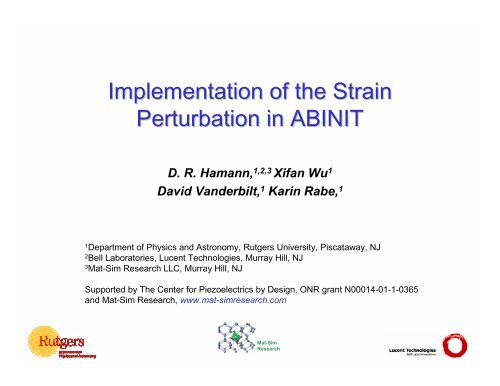
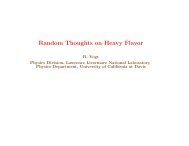

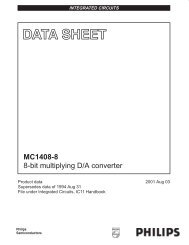

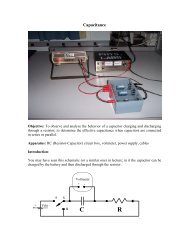


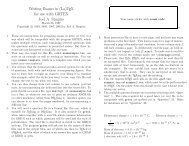
![More Effective C++ [Meyers96]](https://img.yumpu.com/25323611/1/184x260/more-effective-c-meyers96.jpg?quality=85)


